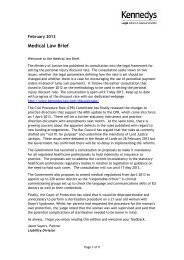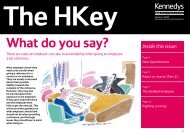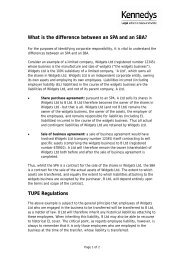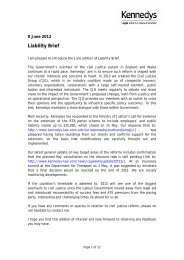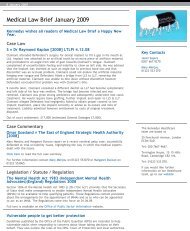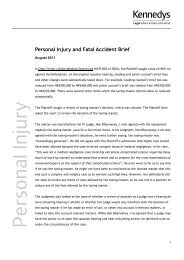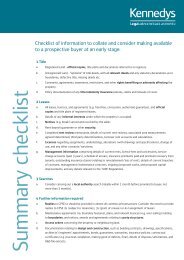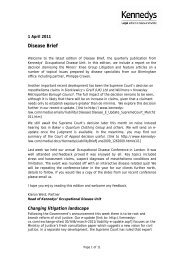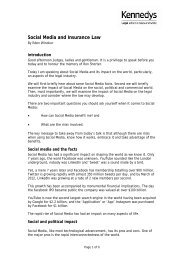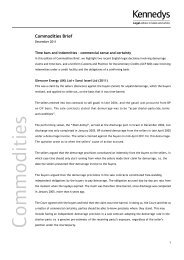Download our Credit Hire Guide - Kennedys
Download our Credit Hire Guide - Kennedys
Download our Credit Hire Guide - Kennedys
Create successful ePaper yourself
Turn your PDF publications into a flip-book with our unique Google optimized e-Paper software.
Motor <strong>Credit</strong> <strong>Hire</strong> <strong>Guide</strong>
Introduction<br />
Since the early 1990s the battle between defendants and the credit hire industry has waxed and<br />
waned. The subject is as relevant today as it was 20 years ago.<br />
<strong>Credit</strong> hire claims handling is often believed to be a dark art, but it need not be. <strong>Kennedys</strong> has a long<br />
history of helping insurers, policyholders and self-insured businesses through the credit hire maze.<br />
We published <strong>our</strong> first credit hire guide in 2000. This latest guide brings together the knowledge<br />
and tactical thinking that has developed within <strong>our</strong> national credit hire team since that time.<br />
As with everything we do at <strong>Kennedys</strong>, we have set this guide out simply, in “black and white”. Also,<br />
as <strong>our</strong> clients have come to expect from us, we have provided a pragmatic and commercial set of<br />
solutions. This will result in reduced claims costs and an enhanced ability to select those cases that<br />
need to be fought.<br />
A credit hire flowchart is included at page 26.<br />
My thanks to Kerry Hawthorne-White and Dylan Magnay for their assistance with compiling this<br />
guide.<br />
Richard West<br />
Partner<br />
<strong>Kennedys</strong> is a trading name of <strong>Kennedys</strong> Law LLP.<br />
<strong>Kennedys</strong> Law LLP is a limited liability partnership registered in England and Wales<br />
(with registered number OC353214)
Contents<br />
Topic<br />
Page Number<br />
1. Defined terms 2<br />
2. What is a credit hire agreement? 3<br />
3. What does the third party have to prove? 4<br />
3.1 Registered keeper and/or registered driver, coverage and insurance issues 4<br />
3.2 Need 4<br />
4. Is the agreement enforceable? 6<br />
4.1 The Cancellation of Contracts made in a Consumer’s Home or Place of Work etc.<br />
Regulations 2008 (Doorstep Regulations) 6<br />
4.2 Electronic signature of agreements 7<br />
4.3 Public policy 8<br />
4.4 Subrogated claims and insurance 9<br />
5. ABI General Terms of Agreement (GTA) 10<br />
6. Offer of an alternative vehicle 14<br />
7. Third party intervention 15<br />
8. Period of hire 16<br />
9. Like for like vehicle 17<br />
10. Impecuniosity 18<br />
11. Failure to mitigate 19<br />
12. Basic hire rate 20<br />
13. Additional extras 21<br />
14. Engineer’s fee 22<br />
15. Interest 23<br />
16. Tactics 24<br />
17. Flowchart 26<br />
18. Case index 27<br />
1
1. Defined terms<br />
We have, where appropriate, used defined terms.<br />
In addition, please note that <strong>our</strong> reference to “insurer” includes the claims handling agent, and<br />
“third party” includes a third party representative.<br />
2
2. What is a credit hire agreement?<br />
A credit hire agreement is an agreement entered into between a third party and a credit hire<br />
provider. The credit hire provider provides a replacement vehicle when the third party’s own<br />
vehicle is damaged in an incident. The period of hire should commence from when the damaged<br />
vehicle is being repaired and/or waiting to be declared a total loss.<br />
The vehicle will be provided to the third party on a credit basis. This reflects the fact that after<br />
the third party has paid the credit hire charges to the credit hire provider once the hire period<br />
has ended, the credit hire provider will seek to recover these costs from the at fault party or his<br />
insurer. In reality, whilst the third party is technically liable for the costs of the hire, these charges<br />
are never actually paid by him but rather, will be paid by the at fault party directly to the credit<br />
hire provider.<br />
A credit hire agreement is not a regulated agreement pursuant to the Consumer <strong>Credit</strong> Act 1974<br />
(1974 Act). Instead, the normal contractual principles such as offer and acceptance apply. The<br />
decisive factor is whether the third party has read and understood the terms and conditions of<br />
hire. The 1974 Act does, however, apply to issues of enforceability discussed at section 4 below.<br />
3
3. What does the third party have to prove?<br />
3.1 REGISTERED KEEPER AND/OR REGISTERED DRIVER, COVERAGE AND<br />
INSURANCE<br />
Insurers should be satisfied that the third party is the registered keeper and/or a registered<br />
driver of the damaged vehicle. For example, if a husband was the registered keeper of the vehicle<br />
which was being driven by his wife at the time of the collision, as long as the wife was a<br />
registered driver she may bring a claim for the recovery of credit hire charges.<br />
In order to establish who the registered keeper is you should request a copy of the V5 from the<br />
third party. If the V5 is not produced it can be obtained directly from the DVLA using Form<br />
V888/2 at a current cost of £2.50.<br />
In order for the third party to bring a claim for recovery, the damaged vehicle should be on the<br />
road legally. This can be proved by seeking from the third party a copy of a valid:<br />
●<br />
●<br />
●<br />
MOT certificate<br />
Certificate of insurance (which can be verified by completing a Motor Insurance Database<br />
search)<br />
Driving license<br />
3.2 NEED<br />
Need is not conclusive. Rather, the third party must prove their need to hire a replacement<br />
vehicle (Giles v Thompson [1993]). In reality, the burden of proof is easily satisfied.<br />
A mitigation questionnaire should be attached to the payment pack or requested separately in<br />
order to confirm the third party’s need for a hire vehicle by reference to:<br />
●<br />
●<br />
●<br />
●<br />
●<br />
Occupation<br />
Mileage<br />
Family/personal circumstances<br />
Social commitments<br />
Other available vehicles<br />
When dealing with claims by taxi drivers you should request a copy of the licence granted by the<br />
local authority authorising carriage of passengers. If the third party does not produce the licence,<br />
enquiries of the relevant local authority should be made.<br />
4
Also relevant to the question of need is whether the third party has access to any other vehicles,<br />
such as family vehicles or vehicles within a fleet/pool (Beechwood Birmingham Ltd v Hoyer<br />
Group UK Ltd [2010]). The relevant consideration is whether such an arrangement would cause<br />
unreasonable inconvenience to the party who permits use of a vehicle to the third party. In the<br />
case of a business, specific evidence of the actual use of the vehicle for business purposes will be<br />
required, as need is not self-proving (Singh v Yaqubi [2013]).<br />
For example, take a wife whose vehicle is damaged and requires repair. The only other<br />
family car is her husband’s which he uses to drive to work, and in the absence of which,<br />
would require him to make alternative travel arrangements. It is unlikely to be considered<br />
a reasonable sacrifice for him to make to allow his wife to use the vehicle.<br />
5
4. Is the agreement enforceable?<br />
In order for a credit hire agreement to be enforceable the third party must be made aware of the<br />
terms and conditions before he enters into the agreement.<br />
4.1 THE CANCELLATION OF CONTRACTS MADE IN A CONSUMER’S HOME OR<br />
PLACE OF WORK ETC. REGULATIONS 2008 (DOORSTEP REGULATIONS)<br />
The Doorstep Regulations came into force on 1 October 2008, apply to all contracts with a total<br />
payment of more than £35 and set the cooling off period to a minimum of seven calendar days.<br />
The location where the credit hire agreement is entered into is, therefore, relevant to determine<br />
whether the Doorstep Regulations apply. The Regulations are aimed at traders who enter into a<br />
contract with a consumer at their home or workplace. However, they also cover contracts made<br />
at another individual’s home or on an excursion organised by the trader away from their business<br />
premises. The Regulations will not apply if the third party is not a consumer e.g. use of vehicle<br />
during c<strong>our</strong>se of employment.<br />
The Regulations also require cancellation rights to be clearly and prominently displayed in any<br />
written contract or provided in writing if there is no written contract. Failure to do so is a<br />
criminal offence (Regulation 7). The notice must:<br />
●<br />
●<br />
●<br />
●<br />
●<br />
Be dated<br />
Indicate the right of the consumer to cancel the contract within the cancellation period<br />
Be easily legible<br />
Contain the information set out in Schedule 4, Part I and a cancellation form in the form set<br />
out in Schedule 4, Part II provided as a detachable slip and completed by or on behalf of the<br />
trader in accordance with the notes<br />
Indicate if applicable that:<br />
●<br />
●<br />
the consumer may be required to pay for the goods or services supplied if the consumer<br />
decides to have work done, or to receive goods, within the seven day cooling off period<br />
a related credit agreement will be automatically cancelled if the contract for goods or<br />
services is cancelled<br />
The written notice must also contain (Schedule 4, Part I):<br />
●<br />
The identity of the trader including trading name, if any<br />
6
●<br />
●<br />
●<br />
●<br />
●<br />
The trader’s reference number or other details to enable the contract or offer to be identified<br />
A statement that the consumer has a right to cancel the contract if he wishes and that this<br />
right can be exercised by delivering or sending (including by email) a cancellation notice to<br />
the person mentioned in the next paragraph at any time within the seven day cooling off<br />
period, starting with the day of receipt of a notice in writing of the right to cancel the<br />
contract<br />
The name and address (including any email address as well as the postal address) of a person<br />
to whom a cancellation notice may be given<br />
A statement that notice of cancellation is deemed to be served as soon as it is posted or sent<br />
to a trader or in the case of an electronic communication from the day it is sent to the trader<br />
A statement that the consumer can use the cancellation form provided if he wishes<br />
If the third party is not made aware of the right to cancel in accordance with the Doorstep<br />
Regulations, the entire credit hire agreement is unenforceable. However, in this situation, the<br />
third party may be able to recover the equivalent of basic hire rates by way of a general damages<br />
award (Wei v Cambridge Power and Light Ltd [2010]).<br />
Be aware: third party representatives have developed certain tactics to avoid<br />
enforceability arguments. These include the provision of a witness statement to confirm<br />
that the third party knew the terms of the agreement and was aware of his right to<br />
cancel before he signed the agreement.<br />
4.2 ELECTRONIC SIGNATURE OF AGREEMENTS<br />
Many credit hire agreements are endorsed at the time the hire vehicle is delivered to the third<br />
party by the third party signing for safe receipt on an electronic handheld device. It is not<br />
uncommon for these signatures to be transposed to the relevant signature sections on the credit<br />
hire agreement.<br />
The concern here is that the third party has not been made aware of the credit hire terms and<br />
conditions before signing the agreement. Even though the credit hire provider will probably<br />
argue that the agreement is enforceable because the agreement is signed, was the third party<br />
aware what they were signing?<br />
Indicators of status of the agreement/third party awareness include:<br />
●<br />
Is the signature obviously electronically transposed?<br />
7
●<br />
●<br />
Do the signatures look identical on the receipt document and the agreement (i.e.<br />
consideration of size and matching letter characteristics)?<br />
Is there a defined shading around the signature?<br />
See Dixon v Arriva [2007] and Tyrell v Staniforth [2009].<br />
Other discrepancies<br />
Another practice surrounding creation of the agreement is to refer the third party to online<br />
terms and conditions. The concern is knowing whether the third party has actually viewed and<br />
agreed to these online. There have been cases where the terms and conditions have apparently<br />
been agreed by the third party at a location where it is unrealistic or unlikely they would have<br />
been. Such a discovery can be achieved by cross referencing the locations with the unique IP<br />
address of the computer on which the terms and conditions have been agreed.<br />
In addition to obvious geographic inconsistencies, the date and time of the purported agreement<br />
should be looked at closely, to ensure they are feasible.<br />
For example, a third party residing in Newcastle is provided with a hire vehicle from the credit<br />
hire provider’s Newcastle branch. However, after carrying out a search of the IP address of the<br />
computer on which the terms and conditions were viewed and agreed, it transpires that the<br />
terms and conditions were in fact agreed to in Plymouth. This is unlikely to be possible unless the<br />
third party had reason to be in Plymouth.<br />
The location of the computer by reference to the IP address can be identified by placing “IP<br />
address locator” into any search engine. You should however be aware that these searches may<br />
not be accurate.<br />
4.3 PUBLIC POLICY<br />
Whilst the credit hire agreement is not a regulated agreement for the purposes of the Consumer<br />
<strong>Credit</strong> Act 1974, the normal contractual provisions apply with regard to enforcement, which are:<br />
●<br />
●<br />
Was the third party made aware of the terms and conditions prior to entering into the credit<br />
hire agreement?<br />
Did he actually sign it?<br />
If either of these provisions is not satisfied the credit hire agreement is unenforceable.<br />
8
Other situations where a credit hire agreement may not be enforceable relate to public policy<br />
issues as follows:<br />
●<br />
●<br />
Using the credit hire vehicle in the commission of an illegal act<br />
Driving a credit hire vehicle when the third party was driving his vehicle at the time of the<br />
collision without insurance or a valid driving license. (The third party would still be able to<br />
bring a claim for personal injury.)<br />
4.4 SUBROGATED CLAIMS AND INSURANCE<br />
As with vehicle damage claims, credit hire providers will seek to recover credit hire charges by<br />
way of a subrogated claim brought in the third party’s name. The right to do so is normally set<br />
out in the terms and conditions of hire.<br />
It is now common to have separate insurance premiums in place running alongside the credit hire<br />
agreement. These pay the outstanding credit hire charges in full on behalf of the third party,<br />
thereby discharging the third party from liability for these charges. The insurance provider will in<br />
turn seek to recover this payment from the at fault party (W v Veolia Environmental Services<br />
(UK) PLC [2011]).<br />
9
5. ABI general terms of agreement (GTA)<br />
Paragraph 1.1 of the GTA states: “These terms of Agreement (GTA) set out the<br />
arrangements between subscribers for the provision of replacement vehicles to third<br />
party motorists (referred to as customers throughout), and, where appropriate, the<br />
undertaking of repairs. Whilst intended to provide comprehensive guidelines, these are<br />
entirely voluntary between the subscribers involved, who may elect to un-subscribe from<br />
the GTA at any time”.<br />
The GTA is only intended to apply to situations where a credit hire organisation (CHO) considers<br />
the third party has prospects of full recovery against an at fault driver’s insurer. All subscribers<br />
are required to follow the GTA in such cases. In all other cases (i.e. those where full recovery is<br />
not anticipated) the subscribers may elect to follow the same principles, provided that they<br />
comply with the spirit and terms of the GTA, including the application of the relevant settlement<br />
rates.<br />
Where the GTA is applied, it can be used to negotiate:<br />
●<br />
●<br />
●<br />
●<br />
●<br />
Daily rates of hire<br />
<strong>Hire</strong> period<br />
Unreasonable delays (see section below on timeframes)<br />
Class of vehicle (as well as ordinary vehicles this includes private hire/taxis, motorcycles and<br />
commercial vehicles)<br />
The necessity for a prestige vehicle<br />
Daily rates<br />
The applicable maximum daily rates are available on the ABI website.<br />
Timeframes: period and delays<br />
The insurer must respond to the CHO’s new claim advice form within five days of receipt<br />
confirming the correct handling centre and claims reference number. If an insurer fails to do so,<br />
it will be responsible for any delays resulting from exchange of notification documents<br />
(paragraph 4.2).<br />
The hire period commences at the time the third party both needs and takes delivery of the<br />
replacement vehicle. Where it is reasonable for the third party to believe that the damaged<br />
10
vehicle is unusable and/or unroadworthy but the engineer subsequently confirms the vehicle to<br />
be usable, the hire will be paid up to the date the disagreement is resolved. The third party<br />
should, however, mitigate his loss by returning his damaged vehicle to the CHO and returning the<br />
credit hire vehicle until repairs can be commenced (paragraph 4.6).<br />
The hire period should end no later than 24 h<strong>our</strong>s after repairs to the third party’s vehicle have<br />
been completed (paragraph 4.8).<br />
The CHO should monitor the hire period throughout the period of the hire and in particular:<br />
●<br />
●<br />
Ensure that repairs have been commenced within three working days of the damaged vehicle<br />
going in for repairs<br />
Make a further check with the garage after the lesser of five working days or three working<br />
days before the hire should have ended (paragraph 4.10)<br />
The insurer should be informed of all “unreasonable” delays with a notification of the delay. If the<br />
repair is delayed beyond these periods, the CHO should undertake checks every five working<br />
days after the original hire period should have ended. Any further delays should be notified to the<br />
at fault driver’s insurer (paragraph 4.11).<br />
An “unreasonable” delay: defined as “delays that are at least two working days longer<br />
than expected or over 20% more than the estimated hire period notified to the CHO”.<br />
Provided that the CHO has correctly monitored the repairs, it will not be held responsible and the<br />
hire period will not be reduced, if an engineer fails to liaise with the at fault driver’s insurer if a<br />
significant delay is likely for required parts (paragraph 4.13) (Clark v Ardington Electrical<br />
Services [2003]). Consideration should, however, be given to bringing contribution proceedings.<br />
Where the third party’s vehicle is deemed a total loss, the CHO should check within ten working<br />
days of the hire commencing, that the vehicle has been inspected and an offer has been made to<br />
the third party. If an offer has not been made, the CHO should inform the insurer. The ten<br />
working day period can be extended by up to f<strong>our</strong> working days, where the CHO’s procedures<br />
provide for an offer being agreed with the third party. The CHO should inform the insurer of any<br />
dispute on the pre-accident value (PAV) so they can consider any appropriate action. The hire<br />
may continue until seven calendar days after receipt of the final settlement cheque by the third<br />
party. The insurer should advise the CHO, on request, as soon as possible of the date on which<br />
their total loss settlement cheque is issued (paragraph 4.14).<br />
11
Where delays result from the insurer not receiving documentation from the CHO, proof of<br />
sending will be accepted by the insurer as the appropriate start date from which penalty<br />
payments apply (paragraph 6.6).<br />
Mitigation<br />
The CHO must advise the third party of his duty to mitigate his losses before and throughout the<br />
period of hire e.g. an overseas holiday without the need of the hire vehicle. The third party must<br />
complete a mitigation questionnaire/statement of truth form as part of the payment pack<br />
(paragraph 4.3).<br />
Class of vehicle<br />
The CHO will normally provide the third party with a hire vehicle in the same class as his own. The<br />
insurer must be consulted in the event of a dispute about entitlement. The third party may opt<br />
for a higher class vehicle or an extension of the hire period at his own cost (paragraph 4.4).<br />
Prestige vehicles<br />
Where the vehicle owned by the third party is a prestige vehicle, the CHO should make enquiries<br />
with the third party to ensure they have need for such a vehicle. Where the prestige vehicle is<br />
over six years old, it is only in exceptional circumstances that a similar prestige replacement is<br />
required. Need will be determined by reference to the make, model, value and use of the vehicle<br />
(paragraph 4.5).<br />
Payment pack<br />
The CHO must submit a payment pack in support of a payment request to the insurer as soon as<br />
full documentation is available.<br />
Content of payment pack<br />
The pack should include a covering letter which sets out all the charges due with<br />
documentation and supporting evidence. This should include a mitigation<br />
questionnaire/statement of truth form signed by the third party and a new claims form<br />
and hire period validation form (loss of use dates), where necessary. If appropriate, the<br />
following should also be included: engineer’s report, repair authorisation details and<br />
details of storage and recovery fees (paragraphs 6.1, 6.2 and 6.3).<br />
12
Penalty payments<br />
Failure to settle the payment pack within one calendar month will result in the following<br />
increases to the total invoice (paragraph 6.8).<br />
<strong>Hire</strong><br />
Repair (if included<br />
in payment pack)<br />
Up to one calendar month None None<br />
Between one and two calendar months 7.5% 2.5%<br />
Between two and three calendar months 15% 5%<br />
13
6. Offer of an alternative vehicle<br />
In order to avoid the third party incurring credit hire charges, the insurer should have in place the<br />
facility to enable them to offer the third party an alternative vehicle at no cost. The cost to the<br />
insurer is likely to be at basic hire rates or less. This is commonly known as “capture” or “third<br />
party intervention” (Copley v Lawn; Maden v Haller [2009]).<br />
Any offers on an alternative vehicle made by the insurer should be made before the third party<br />
enters into any credit hire agreement and should:<br />
●<br />
●<br />
●<br />
●<br />
Be in writing<br />
Be addressed to the third party and copied to the third party’s insurer<br />
Be clear as to the cost of the vehicle to the third party as well as to the insurer<br />
Offer a like for like vehicle<br />
If a third party fails to consider an offer of an alternative vehicle, he risks an argument against<br />
him of failure to mitigate his loss. This could include where there are two periods of hire and the<br />
offer of an alternative vehicle was made after the first period of hire but before the second.<br />
However, even if the third party has unreasonably rejected the offer it is likely that he will be able<br />
to recover basic hire rates. Therefore it is essential that the offer of an alternative vehicle follows<br />
the guidance set out above and is made early.<br />
14
7. Third party intervention<br />
In order to assist in keeping the hire period to a minimum, the insurer should consider whether<br />
any intervention by them could assist. The following are examples of where it would be<br />
appropriate to intervene:<br />
●<br />
●<br />
●<br />
●<br />
●<br />
Offering to inspect the third party vehicle at the outset<br />
Arranging an alternative garage to carry out repairs if for some reason the instructed garage<br />
is delayed/unable to perform the repairs<br />
Offering to s<strong>our</strong>ce and deliver parts if there is a delay by the repairing garage in obtaining<br />
parts<br />
Offering to provide the third party with an alternative vehicle<br />
Arranging a holiday for the third party which would cease their need to hire an alternative<br />
vehicle<br />
If these attempts are made by the insurer but are not agreed to by the third party, there may be<br />
an argument that the third party has failed to mitigate his loss.<br />
15
8. Period of hire<br />
The period of hire will have a significant impact on the value of all credit hire claims. Most<br />
arguments in relation to the period of hire stem from delays caused by various factors, which can<br />
occur in isolation or in conjunction with other reasons. These include delays in the following:<br />
●<br />
●<br />
●<br />
●<br />
●<br />
●<br />
●<br />
●<br />
●<br />
●<br />
The third party or their representative advising the insurer of the collision<br />
The third party instructing an engineer to inspect the damaged vehicle<br />
The insurer instructing an engineer to inspect the damaged vehicle when the third party has<br />
third party cover only<br />
The third party sending the engineer’s report to the insurer<br />
The insurer sending out payment for the pre-accident value of the damaged vehicle when the<br />
third party has third party cover only<br />
The third party authorising repairs<br />
Repairing garages commencing work e.g. due to work backlog<br />
Repairs due to delay in the delivery of parts<br />
The third party providing vehicle documents where relevant e.g. V5, MOT certificate and<br />
driving licence<br />
The third party collecting the repaired vehicle or signing the satisfaction note<br />
If it is impossible to show that the third party personally prolonged a period of hire, the insurer is<br />
likely to be liable for the whole period of hire. Third parties often rely on Clark v Ardington<br />
Electrical Services [2003] to argue this point. Where it is possible to show that the delay was<br />
caused by another party, such as the repairing garage or the credit hire provider, the option of<br />
bringing a claim for contribution can be considered.<br />
16
9. Like for like vehicle<br />
A party should be put back into the position he would have been in had the collision not<br />
occurred. He will not be entitled to a better class of hire vehicle than his own. For this purpose,<br />
reference should be made to the grouping of vehicles within the GTA agreed maximum<br />
settlement rates. CHOs follow this structure but the grouping categories are often labelled<br />
differently.<br />
CHOs will sometimes provide a third party with a better class of vehicle than his own but charge<br />
at the daily rate for his own vehicle class, which is acceptable practice.<br />
17
10. Impecuniosity<br />
The third party must prove that they needed to hire a replacement vehicle on a credit basis and<br />
did not have the financial means otherwise to fund the hire of an alternative vehicle.<br />
The burden of proof is on the third party to establish that they were impecunious at the time of<br />
the collision and had no other option but to hire a vehicle on a credit basis (Lagden v O’Connor<br />
[2003]). However, the insurer holds the overall burden of proving that the third party could not<br />
have hired at a basic hire rate.<br />
A prudent insurer will recognise that third parties and/or their representatives are not always<br />
willing to assist in providing evidence of impecuniosity at the outset. It is therefore advisable for<br />
insurers to begin shifting the burden of proof to the third party by obtaining basic hire rate<br />
evidence early on. This may be by way of internet rates or a pre-litigation rates report from a<br />
preferred rates evidence provider. This report can then also be used for the purpose of litigation<br />
and negotiation (if need be).<br />
In order to establish the third party’s financial position, you should request the following:<br />
●<br />
●<br />
●<br />
●<br />
●<br />
●<br />
●<br />
●<br />
●<br />
Bank statements including details of any overdraft facility (ideally for a period three months<br />
before and three months after the collision)<br />
<strong>Credit</strong> card statements<br />
Savings accounts statements (including any joint accounts)<br />
Details of any loans<br />
Wage slips<br />
Tax returns<br />
Profit and loss accounts<br />
Details of any credit reference problems e.g. county c<strong>our</strong>t judgments<br />
Details of any unreasonable sacrifice which would arise from hiring at basic hire rates<br />
18
11. Failure to mitigate<br />
The third party is always under a duty to mitigate their losses. Examples of ways a third party can<br />
do this are:<br />
●<br />
●<br />
●<br />
●<br />
●<br />
●<br />
●<br />
●<br />
●<br />
●<br />
Utilising public transport<br />
Borrowing/sharing a vehicle from a friend or family member<br />
Arranging hire at basic hire rates from providers such as Enterprise, Europcar, Hertz, Avis<br />
Using the c<strong>our</strong>tesy car from the repairing garage<br />
Continuing to drive the damaged but roadworthy vehicle up until the point of repair<br />
Returning a credit hire vehicle whilst not in use, e.g. during a holiday<br />
Hiring a vehicle which is in the same or lower class than the damaged vehicle<br />
Giving genuine consideration to offers of a replacement vehicle from all parties involved in<br />
the collision and their representatives<br />
Responding to all parties involved in the collision and their representatives promptly<br />
Ceasing hire promptly when repairs are completed or when the pre-accident value cheque is<br />
received<br />
The above can be used to argue that the hire period or rate should be reduced or that the third<br />
party should not have hired a vehicle on credit at all.<br />
19
12. Basic hire rate<br />
If the third party is unable to prove that they were impecunious at the time of the hire then the<br />
appropriate daily rate of hire should be limited to the market rate. This is otherwise known as the<br />
“basic hire rate” (Bent v Highways & Utilities Construction and Allianz Insurance [2011]).<br />
The basic hire rate is the rate at which the third party should have been able to obtain a vehicle<br />
on a non credit hire basis. The appropriate basic hire rate is for:<br />
●<br />
●<br />
●<br />
●<br />
Like for like vehicle<br />
Same location as the third party<br />
Same period of hire<br />
At the same time as the hire period<br />
If evidence fitting the above criteria cannot be obtained then basic hire rates as near as possible<br />
to the above criteria will be considered sufficient.<br />
Whilst not impossible, it can be difficult to obtain basic hire rate evidence for taxis, motorcycles<br />
and commercial vehicles. Again, the above criteria should be applied.<br />
The third party may still be able to recover credit hire rates even if they are not impecunious and<br />
can demonstrate there was no other option but to hire on a credit hire basis. Examples would be<br />
if they had driving convictions or were under the age of 25.<br />
20
13. Additional extras<br />
It is not uncommon for CHOs to include additional charges in the payment pack. These will<br />
include items such as:<br />
●<br />
●<br />
●<br />
●<br />
●<br />
●<br />
●<br />
●<br />
●<br />
●<br />
●<br />
●<br />
Collision damage waiver<br />
Underbody waiver<br />
Windscreen waiver<br />
Theft excess waiver<br />
Young driver excess<br />
Additional driver surcharge<br />
High mileage charge<br />
Satellite navigation charge<br />
Automatic vehicle charge<br />
Road tax<br />
Additional insurance<br />
Dual control charge (driving instructor)<br />
Assessment of whether additional items such as these are recoverable should be considered on a<br />
case by case basis. For example, if a third party had an automatic vehicle and was 18 years old at<br />
the time of the collision, he will be entitled to recover a young driver’s excess and automatic<br />
vehicle charge.<br />
However, many of these items are not recoverable under the credit hire agreement and should<br />
be removed for calculation purposes as they constitute additional benefits which can only be<br />
seen as betterment.<br />
21
14. Engineer’s fee<br />
Any engineer’s fee which is claimed by the third party where the CHO also arranged the repairs is<br />
not a recoverable head of loss as this is considered as an additional benefit (Clark v Ardington<br />
Electrical Services [2003]).<br />
22
15. Interest<br />
Interest is regularly claimed on credit hire charges but is not recoverable. The point is that<br />
interest cannot be claimed on charges that are not yet paid (Pattni v First Leicester Buses Ltd<br />
[2011]).<br />
23
16. Tactics<br />
Without prejudice payments<br />
Whether a third party vehicles is damaged beyond economical repair or is repairable, a without<br />
prejudice payment to settle the pre accident value or repairs should be made in order to cease<br />
the hire. These payments should be made even if liability is in dispute as they can be recovered if<br />
the third party admits being, or is held to be, fully or partially at fault.<br />
Review the credit hire agreement<br />
The credit hire agreement should contain information about the third party’s age, occupation and<br />
driving licence endorsements. By reviewing this information assumptions can be made in relation<br />
to the financial status of the third party and his potential ability to hire a vehicle at basic hire<br />
rates. This should always be clarified with questions to the third party (or his representative).<br />
Offers<br />
It is advisable that you make offers to settle the third party’s credit hire claim as soon as possible.<br />
The CHO will often accept a reduced sum to that claimed in total in order to conclude matters<br />
swiftly.<br />
Obtaining evidence<br />
You should support any offers of settlement with y<strong>our</strong> own evidence from a basic hire rates<br />
provider, internet research or ABI based calculations.<br />
Obtaining evidence as near to the collision date as possible is important to help ensure accuracy.<br />
Challenging rates evidence<br />
When the third party representative or CHO presents their own evidence this should be<br />
challenged as soon as possible if you feel there is merit in doing so. This may include challenging<br />
the:<br />
●<br />
●<br />
Independence of the evidence: for example evidence provided by subsidiaries of the CHO<br />
Comparability of the evidence: by reference to vehicle class, hire period, location or time of<br />
hire<br />
24
Period<br />
A realistic approach should be taken when advancing arguments in relation to the period of hire.<br />
Any arguments challenging the hire period on the basis of delays not caused by the third party<br />
directly are unlikely to be successful (Clark v Ardington Electrical Services [2003]). If there are<br />
arguments that others caused the delay – including the repairing garage, third party’s insurer,<br />
CHO or accident management company – they may need to be joined to any c<strong>our</strong>t proceedings.<br />
However, careful consideration should be given before joining others for reasons of costs and<br />
should only be done if the delays caused are significant.<br />
25
17. Flowchart<br />
The flow chart below sets out the most common issues to be considered when defending a<br />
credit hire claim.<br />
Claim for credit hire presented<br />
Yes<br />
Is the vehicle legally<br />
on the road<br />
Has the third party proved he<br />
is the registered keeper<br />
and/or named driver?<br />
No<br />
Yes<br />
No<br />
Is the credit hire<br />
agreement<br />
enforceable?<br />
No claim<br />
No<br />
Doorstep<br />
Regulations notice<br />
given?<br />
Yes<br />
But<br />
Are there any issues with<br />
electronic signature of the<br />
credit hire agreement?<br />
Yes<br />
No<br />
Not enforceable<br />
Not enforceable<br />
Enforceable<br />
Enforceable<br />
Was there a need<br />
for hire?<br />
No claim<br />
No<br />
No<br />
Yes<br />
Has there been an<br />
offer of an<br />
alternative vehicle?<br />
Did the third party<br />
mitigate his loss<br />
Yes<br />
No<br />
Yes<br />
Not precluded from<br />
claiming credit hire<br />
Still allowed to claim<br />
credit hire<br />
Basic hire rate<br />
Was the third party<br />
impecunious<br />
Period of hire<br />
No Yes Considerations<br />
Like for like<br />
Basic hire rate<br />
<strong>Credit</strong> hire rate<br />
Additional extras<br />
26
18. Case index<br />
Beechwood Birmingham Ltd v Hoyer Group UK Ltd [2010] EWCA Civ 647<br />
Bent v Highways & Utilities Construction and Allianz Insurance [2011] EWCA Civ 1384<br />
Clark v Ardington Electrical Services [2003] UKHL 64<br />
Copley v Lawn; Maden v Haller [2009] EWCA Civ 580<br />
Dixon v Arriva [2007] CL 08/620<br />
Giles v Thompson [1994] 1 AC 142<br />
Lagden v O’Connor [2003] UKHL 64<br />
Singh v Yaqubi [2013] EWCA Civ 23<br />
Tyrell v Staniforth<br />
[2009] unreported<br />
Pattni v First Leicester Buses Ltd [2011] EWCA Civ 1384<br />
W v Veolia Environmental Services (UK) PLC<br />
Wei v Cambridge Power and Light Ltd<br />
[2011] EWHC 2020 (QB)<br />
[2010] unreported<br />
27
Key contacts<br />
Key contacts<br />
Kathy Dwyer<br />
Partner<br />
+44 162 262 5625<br />
k.dwyer@kennedys-law.com<br />
Niall Edwards<br />
Partner<br />
+44 114 253 2041<br />
niall.edwards@kennedyslaw.com<br />
Jennifer Harris<br />
Partner<br />
+44 845 838 4816<br />
jk.harris@kennedys-law.com<br />
Richard West<br />
Partner<br />
+44 845 838 4832<br />
r.west@kennedys-law.com<br />
Authors<br />
Kerry Hawthorne-White<br />
Solicitor<br />
+44 845 838 4810<br />
k.hawthorne-white@kennedyslaw.com<br />
Dylan Magnay<br />
Litigation Manager<br />
+44 845 838 4861<br />
d.magnay@kennedys-law.com




